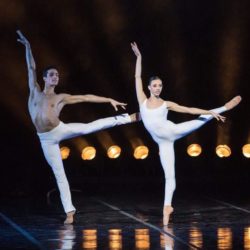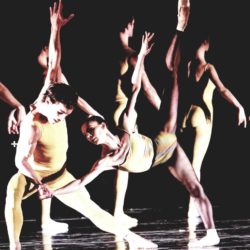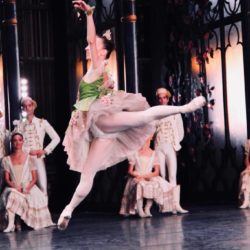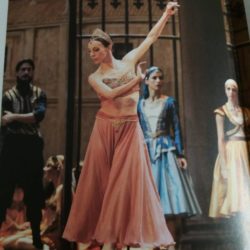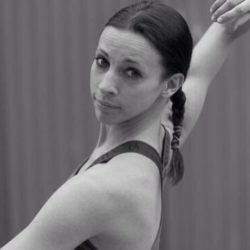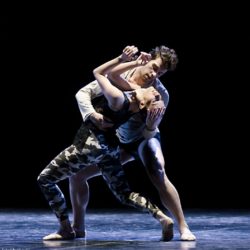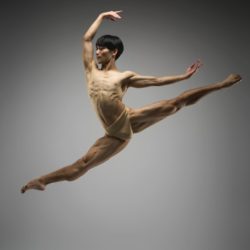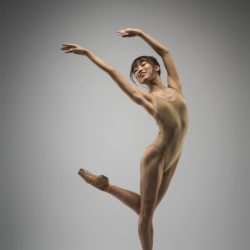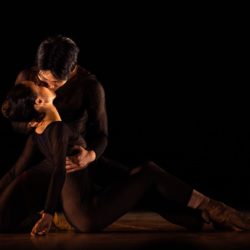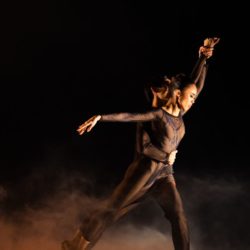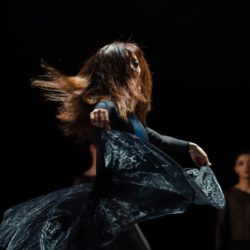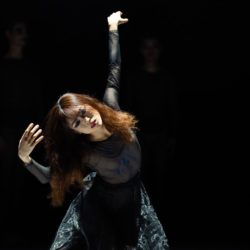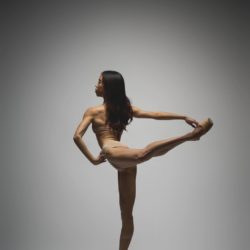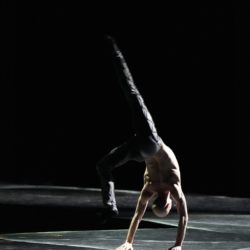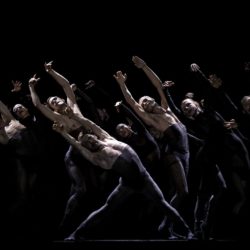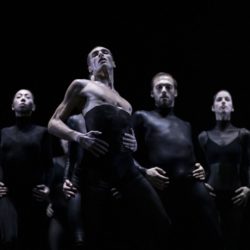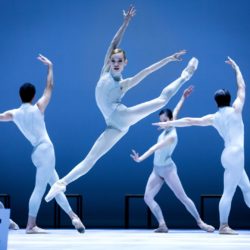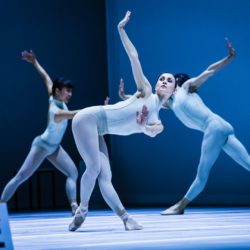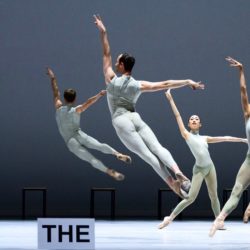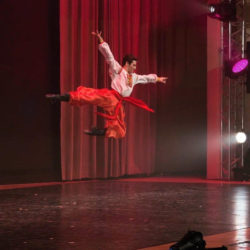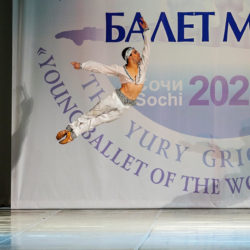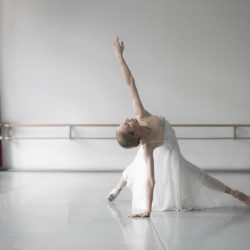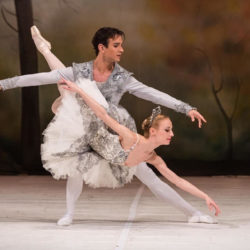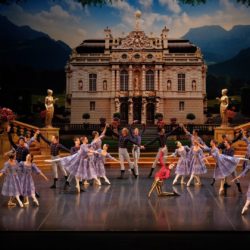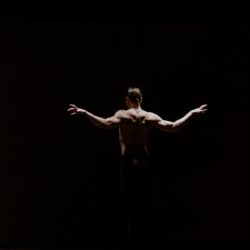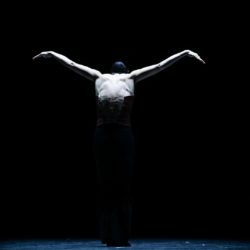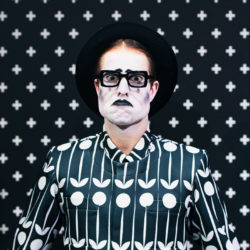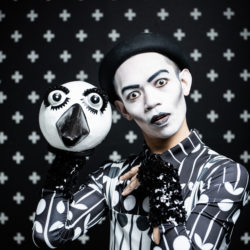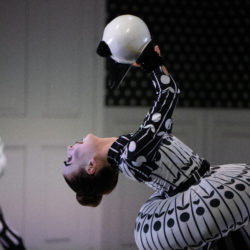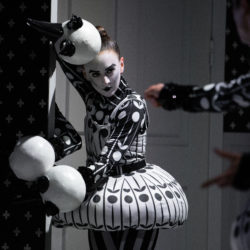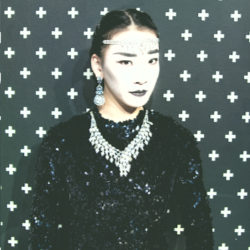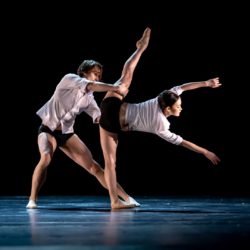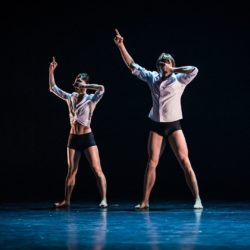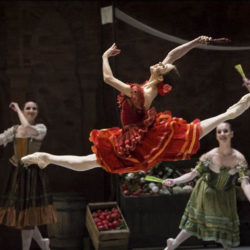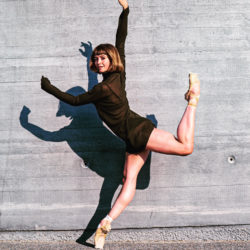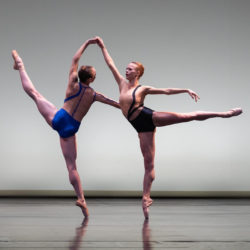Chorea 2023

The ballet of the Teatro dell’Opera di Roma
The ballet of the Italian National Theater – Teatro dell’Opera di Roma was created together with the original establishment of the theater back in 1880. During its history, it changed its name several times, which was related to various historical events as well as to the reconstruction of the theater building.
The ballet experienced its greatest boom in the second half of the 20th century, and today it is the most prestigious ballet operating as part of the National Theater in Italy.
It attracts whole generations of viewers with its varied range of performances and genres. The ballet gives space to Italian as well as foreign choreographers and dancers. Currently, she is the artistic director of the Eleonora Abbagnato ballet. During its time, the ballet studied a huge number of choreographies by such important choreographers as Petit, Bausch, Forsythe, Neumeier, Kylián, Robbins, Béjart and Preljocaj
The ballet is the recipient of many international awards.
Federica Maine
Born in Recco (Genova, Italy) in 1985, she begins her ballet studies in Bergamo with teacher Maria Luisa Rota. She then gets accepted to the Ballet School of the Accademia Teatro della Scala in Milan and eventually continues her training with Wiebe Moeys. She takes part in numerous competitions such as the “International Dance Competition” in Spoleto (where she placed second). Part of the “Maggio Danza” company of ballet from 2006 until its dismissal in 2015, she takes part in the creations of choreographers such as Lucinda Childs and George Balanchine and she works with renowned artists in the likes of Foniadakid, Soto, Bombana, Moricone, Monteverde, Preljocaj, Derevianko, Nappa, Ventriglia And Mancini. She plays the role of Odette/Odile in “Swan lake” by Chalmer and in June of 2012 she receives the “Danza&Danza” award as Young Emerging Talent. In 2014 Davide Bombana chooses her to interpret his Prélude à l’aprés-midi d’un faune and, afterwards, in his rendition of Carmen. In August 2015 she enters the corps de ballet of “Teatro dell’Opera di Roma” directed by Eleonora Abbagnato, that installs her as soloist in 2018 on May 28th. For this establishment she danced in Swan lake (Wheeldon; Pech), The Nutcracker (Peparini), The Bat (Petit), Carmen(Petit, Jiří Bubeníček). She also played solo roles in Giselle(Rouane), Sleeping Beauty (Jean-Guillaume Bart), Don Chisciotte (Hilaire), Serata Philip Glass and Glass Pieces(Robbins), l’Archange in Annonciation by Preljocaj, Herman Scherman (Forsythe), From Afar (new productionof Nicolas Blanc), Myrtha in Giselle by Fracci, Gamzatti in La Bayadere (Benjamin Pech), Lise in La Fille mal Gardée (Ashton).
Lorenzo Terzo
His professional ballet career is connected with many prestigious ballet companies, such as the Staatsteather Nürnberg Ballet under the direction of Goya Montero, or the ballet of the National Theatre in Mannheim under the direction of Stephan Thoss. During his career, he performed as a soloist in many ballet performances not only of these companies, but also as a guest soloist in other ballet companies. Many modern ballet choreographers chose him for the main roles, such as Jeroen Verbruggen, Marco Goecke, William Forsythe, and Christian Spuck.
He is currently guesting as a soloist of the Ballet of the National Theatre in Rome.

Ballet de Barcelona
The Ballet de Barcelona has already performed 93 performances for more than 49,000 spectators with its 8 shows. In addition to its extensive tour of Catalonia, it has performed in other parts of the country such as Alicante, Murcia and Logroño, and has also established an international presence with its tours of France and Andorra. Its international artists have represented the company as guest artists in various dance galas in countries such as Sweden, Japan, Switzerland and the United States. Recently the Ballet de Barcelona has danced at the prestigious Ubumuntu Arts Festival in Rwanda (Africa), as well as on the fashion runway of the 080 Barcelona Fashion 2023 for ESCORPION.
The company now has artists of many nationalities, and is an international reference in the world of classical and contemporary dance.
Since its inception, the loyalty of theaters, festivals and auditoriums, and the enthusiastic response of its audience, have been key to its development and growth. Also the specialized press (such as Cristina Marinero for Ópera World, Carmen del Val for El País, Marta Porter for the newspaper Ara, Valeria Gaillard for El Punt Avui and Recomana, or Norman Marsa for En Platea), which follows the company and echoes its premieres and its achievements, has contributed in this path towards the construction of an own and differentiatedrepertory within the diverse stylistic forms explorable in the art of dance.
The Ballet de Barcelona is proud of its multiple collaborations with La Marató de TV3, MindLeaps (Africa), Esbart Dansaire de Rubí, RTVE, Colla Castellers de Sarrià, Xiquets de Reus, Apropa Cultura, ESMUC. LleidArt Ensemble, Centro Cultural Terrassa, Fupar, Jove Ballet de Cataluña, Gerona en Movimiento and Apropa Cultura, with whom a great social work is being done to bring dance to vulnerable groups.
Hisaki Ida
Hisaki is originally from Osaka, Japan, and began dancing at the age of 3 at Yogachi Yasuko Ballet Studio.
In 2018, Kasai began her professional training at the Alberta Ballet School with Murray Kilgour. In 2018 and 2019, as an apprentice she performed some roles from corps de ballet such as “Snowflakes”, “Waltz of the Flowers” at Nutcracker and “Nymphs” in Sleeping Beauty at Alberta Ballet Company.
In 2020, she joined Ballet de Barcelona as a trainee. At Ballet de Barcelona, Hisaki performed “Chinese Dance Soloist”, “Sugar Fairy”, “Snow Waltz Soloist”, “Waltz of the Flowers corps de ballet” in Nutcracker, and “4 Swans” in Swan Lake, and “Bird” in Peter and the Wolf. She also danced in “Together” “Tounges” “Perspectives”.
Anna Ishii
Born in Japan, Anna began her dance training at the age of 5 at the Yamada Ballet Studio in her hometown. She also trained at the Australian Ballet School in Australia and the Royal Ballet School of Antwerp in Belgium, and attended several summer programs, such as American Ballet Theatre and P.A.R.T.S. headquarters of the company Rosas, in Belgium.
After graduating from the Royal Ballet School of Antwerp, Anna returned to Japan and joined Tokyo City Ballet where she danced Swan Lake, Nutcracker, Coppelia, Romeo and Juliet, Giselle, Sleeping Beauty, Paquita, and The Carnival of Animals, among others. She also danced leading roles in choreographies created exclusively for company.
After her 5 years with Tokyo City Ballet, she decided to return to Europe to join the Ballet de Catalunya, where she worked with Remi Wortmeyer and Larissa Lezhnina.
In 2019, she joined Ballet de Barcelona from its first day and made her debut in June 2019 at the Condal theater in Barcelona. She has performed Le Corsaire Pas de Deux and debuted as The Sugar Fairy in The Nutcracker in December 2019. In January 2020, she makes her debut as choreographer in the new production of Ballet de Barcelona with Peter and the Wolf.
Ricardo Bravo
Ricardo was born in Lagos de Moreno, Jalisco (Mexico) in 2000 and began her artistic training at the age of 15 with Daniella Andrada, director of the Dancar School and company Fractal. She trained mainly in contemporary dance, dancing in prominent theaters such as Teatro Degollado, PALCCO, Diana and Rosas Moreno.
Early in her career she managed to win different awards and scholarships. In 2017 Bravo participated in the Argentine competition ‘Danzamerica’, obtaining the second place in contemporary and opening the door to Barcelona Spain where she began her professional studies of classical ballet and character dances endorsed by the University Rey Juan Carlos (higher institute of dance “Alicia Alonso”) headquarters Barcelona Dance Center, working with choreographers such as Ramon Oller, Leandro Perez, Daniel Sene and Elizabeth Perez.
In 2019 Ricardo participated in the summer Cuballet where she worked with Laura Alonso, Hector Figueredo and Orlando Salgado, debuting with the role of “Espada” in the ballet ‘Don Quixote’ at Auditori in Sant Cugat.
He is currently a dancer in the contemporary company Eyan Dance Company directed by Andrea Sala and continues his professional experience with Ballet de Barcelona, under the direction of Chase Johnsey and Carlos Renedo, where he has had the opportunity to dance in the productions ‘Nutcracker’, ‘Mixed Bill’, ‘Pedro y el Lobo’ and ‘Tongues’, working with choreographers such as Anna Ishii, David Rodriguez, Chase Johnsey and Luke Prunty.

Staatsballett Berlin
The Staatsballett Berlin was founded in 2004 as a result of the reunification of the former ballet ensembles of Berlin’s three opera houses – the Deutsche Oper Berlin, the Komische Oper Berlin and the Staatsoper Unter den Linden. The consolidation made the Staatsballett the biggest company in Germany (81 dancers) and the only classically trained ballet ensemble under the umbrella of the Stiftung Oper in Berlin. From 2004 to 2014, Vladimir Malakhov was the company’s first artistic director, followed by Nacho Duato (2014 to 2018). For the 2018/19 season, Johannes Öhman took over as Director of the Staatsballett Berlin; for the 2019/20 season, he was joined by Sasha Waltz in a co-directorship. Dr. Christiane Theobald took over as provisional artistic director in August 2020. From the 23/24 season on, Christian Spuck take over as the company’s new artistic director.
Arshak Ghalumyan
Arshak Ghalumyan was born in Armenia in 1985. He graduated at Armenian national ballet school in 2004. He followed on to Hamburg ballet school and got his first engagement with Staatsballet Berlin where he was promoted to demi-soloist in 2006 and soloist in 2010. In 2018 he became co-artistic director of the ballet troupe and then the artistic advisor and ballet teacher for Mentorship program in 2021/2022 and 2022/2023.
Throughout his career he received numerous awards. He was the finalist of Prix de Lausanne, Istanbul international ballet competition and some others. He has worked with choreographers like Patrice Bart, Vladimir Malakhov, Jiři Kylian, William Forsythe, Jerome Robbins, George Balanchine, Clark Tippet, Angelin Preljocaj, Nacho Duato, John Cranko, Tim Plegge, Vasily Medvedov and Yuri Burlaka, Stanton Welch, Maurice Bejart, John Neumeier, Giorgio Madia, Ronald Savkovic, Boris Eifman, Mauro Bigonzetti, Kenneth Macmillan, Jean-Christophe Maillot, Benjamin Millepied, Gentian Doda, Ohad Naharin, Mats Ek, as well as Marcia Haydee.
For Staatsballett Berlin he created choreographies M.U.S.A., CO20, Mare Crisium, Promenade. He also created choreographies for Korea Ballet, Ballet Entertainment, Stara Zagora State Ballet (Bulgaria), Ballet Arabesque (Bulgaria) and State ballet school Berlin (Germany).

National Ballet of Bosnia and Herzegovina
The National Theatre in Sarajevo was founded in November 1921. The opening ceremony was led by Branislav Nušić, then head of the art department of the Ministry of Education. On November 9, 1946, the Sarajevo Opera began its artistic activity with the premiere of B. Smetana’s play The Bartered Bride.
The Sarajevo Ballet was also founded in 1946, but its first solo performance of Žatva B. Papandopula was postponed until May 25, 1950. This performance marked the beginning of his professional development within the National Theatre.
During its existence, the National Ballet of Bosnia and Herzegovina became a prestigious ballet company that hosted many prestigious choreographers and dancers throughout its history. With its artistic quality and wide repertoire including many ballet genres, it has found its place among the prestigious ballet companies of Europe.
Tamara Ljubičić
Tamara Ljubičić was born on February 19, 1990 in Novi Sad. She finished primary and secondary ballet school in 2008 at the Novi Sad Ballet School in the class of Biljana Njegovan. In the same year, she was engaged in the Ballet of the Serbian National Theatre, and a year later she was engaged in the ballet ensemble of the National Theatre in Sarajevo. As the ballet first soloist, of the National Theatre Sarajevo, she dances the main roles in all ballets of the classical and modern repertoire. She collaborates with prominent domestic and guest choreographers such as Davide Bombana, Vasilij Medvedev, Edward Clug, Dinko Bogdanić and many others.
Oleg Karatsev
He was born in the south of Russia in the small town of Vladikavkaz, where he began his choreographic education at a local school. He later moved to Moscow and after his studies became a graduate of the Bolshoi Ballet Academy (2016). During his graduate internship, he performed in John Neumeier’s ballet “Seasons”.
He received a bachelor’s degree in choreography from the Bolshoi Ballet Academy (2020).
Since 2016, he has been a soloist of the Russian State Ballet, in 2018 he was promoted to lead soloist. Since October 2022, he has been the leading soloist of the National Theater in Sarajevo.
His repertoire includes the main roles in the ballets Swan Lake, Nutcracker, Giselle, Don Quixote, La Bayadere, Ondine, Chipollino, Le corsair, Esmeralda and many others.
He is the winner of several international ballet competitions, such as Young Russia grand prix 2012, Dance Moscow 2019, Young ballet of the world 2021 and others.

Latvian National Ballet
The Latvian National Ballet is the only professional ballet company in Latvia. Latvian ballet’s history of almost hundred years has close ties with the finest traditions of the Russian school of classical ballet. In this way, the classical Russian ballet traditions were passed down from generation to generation, and eventually gave the world such ballet stars as Mikhail Baryshnikov, Māris Liepa, and Alexandr Godunov, each of whom trained right here in Riga.
Today, the Latvian National Ballet’s repertoire is based on the “pearls” of classical ballet – like Giselle, Swan Lake, The Nutcracker, Don Quixote, Le Corsaire, La Bayadère – as well as classic productions by contemporary choreographers that have become audience favourites, such as Coppélia, and The Fountain of Bakhchisaray. Important part of the repertoire is also the neo-classical and contemporary ballets like Dracula, Nijinski, Serenade and Carmina Burana. Choreographer Aivars Leimanis has been the Latvian National Ballet’s artistic director since 1993. He has focused his attention on both, revivals of classical ballets and collaborative projects with renowned choreographers, including Krzysztof Pastor, Marco Goecke, Edward Clug, Hans van Manen, Thierry Malandain, Christian Spuck, Boris Eifman, and Petr Zuska.
The Latvian National Ballet has presented guest performances at the Theater du Chatelet, in Paris; the Bolshoi Theater, in Moscow; China National Centre for the Performing Arts; Staatsoper Hannover; the Teatro La Fenice, in Venice; the Rome Opera House; Edinburgh’s Festival Theater; the Maison de la Danse, in Lyon; the Stanislavsky Nemirovich-Danchenko Theater, in Moscow; and on many other stages all over the world.
The Latvian National Ballet consists of more than 60 dancers among them are laureates of prestigious international ballet competitions – Moscow International Ballet Competition, Korea International Ballet Competition, Valentina Kozlova International Ballet Competition, South African International Ballet Competition and others.

Skånes Dansteater
Skånes Dansteater
In the late summer of 1995 Skånes Dansteater emerged as an independant dance company. After four decades of classical ballet, operas, operettas and musicals the Malmö Ballet at the Malmö City Theatre there was a new artistic endeavour to begin.
Through the years since then hundreds of productions have been created from the will to change and develop within and through dance.
We are Sweden’s only independent dance company. We are funded by the Municipality of Skåne. This means that we are owned by the residents of Skåne and that we belong to everyone.
Skånes Dansteater is Sweden′s largest independent dance company. We are a contemporary dance repertory ensemble presenting works by Swedish and international choreographers.
Skånes Dansteater is a member of Swedish Performing Arts
Tiemen Stemerding
Tiemen has been dancing with Skånes Dansteater since 2018 performing works by for example Örjan Andersson, Tero Saarinen, Fernando Melo, Mari Carrasco, Heidi Vierthaler, Anouk van Dijk, Erika Silgoner and Marcos Morau . He was born in 1995 in The Netherlands, where he received his training at Codarts University of the Arts in Rotterdam. Before joining the company, he worked for example with Miquel G. Font at Habemus Corpus in Barcelona and in Theater Bielefeld led by Simone Sandroni. 2018 he was awarded the regional “Young Talent Prize” of Overijssel.
Hanna Nussbaumer
Hanna has been dancing with Skånes Dansteater since 2020 in choreographies by Mari Carrasco, Erika Silgoner, Anouk van Dijk, Tero Saarinen, Fernando Melo and Marcos Morau. She was born in 1992 in Sydney, Australia. After graduating from the Ecole Ballet School, she moved to London and graduated with BA (Hons) from the Rambert School of Ballet and Contemporary Dance. Hanna continued her studies at the London School of Contemporary Dance graduating with a Master of Arts Degree (dance). She has been an intern with Danish Dance Theatre before accepting a job at Norrdans in January 2015. There she had the opportunity to work with many choreographers including Mats Ek, Jo Strømgren, Martin Forsberg, Tina Tarpgaard, Yossi Berg and Oded Graf and Katrin Hall.
As freelance performer she has been active in both Prague and London. Furthermore, she continues to study for her Romana’s Pilates Degree.
Michael Marquez
Michael has been dancing with Skånes Dansteater since 2022 working with choreographers Johanna Nuutinen, Tero Saarinen and Marcos Morau. Born and raised between the Philippines and Italy, Michael holds a BFA from The Juilliard School. He has performed and collaborated in reconstructions and new creations of works in companies like GroundWorks Dance Theatre (USA) and Phoenix Dance Theatre (UK). During his time in the UK, he was also a freelance performer with project-based UK companies (Rendez-Vous Dance, DeNada Dance Theatre and Eleesha Drennan Dance), a guest teacher for companies and educational institutions and a self-producing maker.
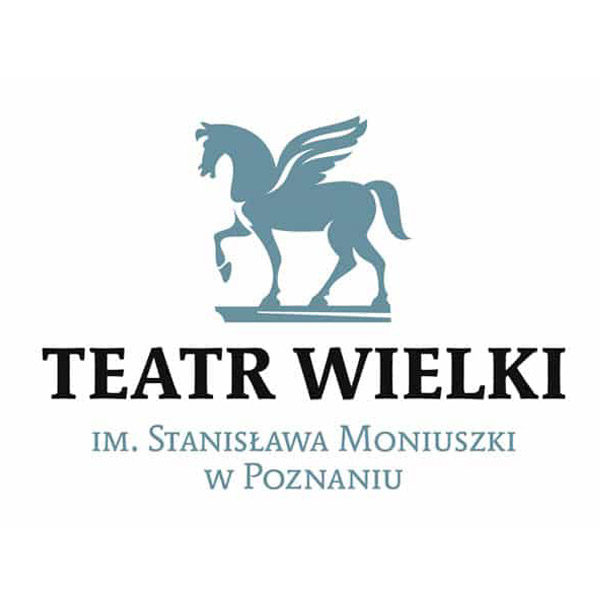
Poznań Opera Ballet
The Beginnings (1919-1939)
The history of Poznań Opera Ballet began in 1919 with the outset of the Opera House itself. The company numbered only 13 people then, including the manager. Among them were: Helena Sławińska, Władysława Kuleszyna, Leokadia Kacperska, Janina Cieślak, Wacław Wierzbicki, Marian Winter, Roman Morawski and Lucjan Chrzanowski. After the restoration of Poland’s sovereignty in 1918, the first ballet evening in Poznań, entitled Polish Fields, was conceived by a dancer, a choreographer and the first manager of Poznań Opera Ballet Michał Kulesza. The ballets staged in the season 1920/1921 included: A Cupid’s Gag, The Caucasian Episode, The Doll’s Fortune-teller, Serenade and Divertissement III.
After two seasons the leadership of the company was taken by Roman Morawski who staged: Cavalry Stopover, Ukrainian Dances, Coppelia, Oj, ułani, ułani, Divertissement IV, With Spring, and The Song of Life. In season 1923/1924 the choreographies for Poznań ballet were created by Jan Ciepliński, a graduate of Warsaw Ballet School. Despite staying in Poznań just for one season, he carried out The Fairy Tale, Lithuanian Rhapsody, Divertissement V, The Carnival, Afternoon of a Faun, The Steppes, Divertissement VII, The Doll’s Fortune-teller and Zephyrus and Chloris.
Ciepliński left before the beginning of the next season and the company was thus overtaken by Maksymilian Statkiewicz, known for his performances with Sergius Diagilew’s Ballets Russes. Statkiewicz came back to Poland in 1924 and became involved with Poznań Opera House where he not only created an outstanding ballet company but also gained reputation of one of the best ballet master of mid-war Poland. In years 1924–1930 and between 1933 and 1939 he created choreographies to 19 ballet performances. In February 1925 he staged Szopenian as well as completed a brand new ballet evening, combining The Doll’s Fortune-teller withBorodin’s Some Polovtsian Dances. The1928 Scheherazade received massive acclaim from both the audience and the critics. Wedding in the Village was staged in December of the same year. In 1929, encouraged by the success of Scheherazade, Statkiewicz realized two premieres, namely The Tatras by Nowowiejski and Pan Twardowski by Różycki.
Maksymilian Statkiewicz left Poznań for three years in 1930. During this time the ballet company had three directors: Józef Ciesielski who staged performances of Harlequin’s Millions and The Hungarian Rhapsody, Konrad Ostrowski and Helena Grossówna-Cieślińska. Back in Poznań in 1934 Statkiewicz staged An Italian Caprice.
In April 1938 Poznań Opera Ballet as the first group in Poland staged Karol Szymanowski’s Harnasie as well as Igor Stravinsky’s Firebird. The theater in Poznań was the fifth in Europe (after Prague, Paris, Belgrade and Hamburg) to stage Szymanowski’s work. Jerzy Kapliński was entrusted with the title role, Zofia Grabowska performed as the Bride, Mieczysław Sawicki danced the part of the Groom, while Statkiewicz himself portrayed the Father. The performance met with a substantial enthusiasm among the audience and the critics. The rendition in Poznań was watched by composer’s sister, Stanisława Szymanowska-Korwin, who uttered great approval of the spectacle, claiming it the best performance she had so far seen.
During the last season before the outbreak of the Second World War, Harnasie was staged 10 more times and a premiere of Statkiewicz’s The Doll’s Fortune-teller cameto fruition. When the Second World War broke out, Maksymilian Statkiewicz along with his wife and prima ballerina Zofia Grabowska were displaced and after the Germans had taken it over, Poznań Opera House became known as Grosses Haus.
After the War
In 1945 about a dozen members of the former ballet company reported to Zygmunt Wojciechowski who had began to restore Poznań Opera House teams in February. Zygmunt Wojciechowski asked Bronisław Mikołajczyk to complete a new ballet company. Stanisław Miszczyk appeared “under the Pegasus” in 1945 and became known not only for creating choreographies but also for founding the Opera Ballet School. As it turned out, one of the attendants was the soon-to-be the most eminent Polish prima ballerina Olga Sawicka. Jerzy Kapliński, the memorable Harnaś from Szymanowski’s ballet, came back to Poznań along with Barbara Bitterówna at the end of 1945. He took the leadership of the company the same year. The first post-war ballet evening took place on April 6th, 1946 and comprised of The Fairy Tale, The Trifling and Divertissement IX. In course of 4 years Kapliński staged 11 ballets.
Between the seasons 1949/1950 and 1962/1963 the post of the manager of the ballet company was held by many key figures of the Polish post-war dance history. To wit: Eugeniusz Papliński, who conceived a new version of Tadeusz Szeligowski’s ballet The Peacock and the Girl; Leon Wójcikowski – the choreographer of Dyl Sowizdrzał, The Spanish Suite, The Seasons and The Sorcerer’s Apprentice; Stanisław Miszczyk who having come back to Poznań staged the first after war Swan Lake; Feliks Parnell (Różycki’s Pan Twardowski), Jerzy Gogół (Sleeping Beauty – Polish world premiere of Tchaikovsky’s ballet, The Song of the Earth and Love, the Magician), Zygmunt Patkowski and Władysław Milon (Prokofiev’s Romeo and Juliet).
Drzewiecki’s Time
Robert Satanowski became Poznań Opera House General Director in 1963 and invited Conrad Drzewiecki to become the new manager of the ballet company. Due to Drzewiecki’s talent and charisma, Poznań became the hub of Polish ballet life for the next 10 years. In Poznań Opera House Drzewiecki staged 25 choreographies, incessantly experimenting and surprising.
After Conrad Drzewiecki’s departure, the managers of Poznań Opra Ballet included Barbara Kasprowicz (Giselle, The Nutcracker and Don Quixote) and Henryk Konwiński (Romeo and Juliet, La peri compilation, Epitaph and Carmen). Emil Wesołowski led the company for one season and finalized Serenade and The Countess. The part of the Countess was performed by Ewa Pawlak who became the company director a few months later. In 1988 Mirosław Różalski, Drzewiecki’s long-term assistant, took over the company, having left Polish Dance Theatre. “Under the Pegasus” he staged: The House of Bernarda Alba, Quasimodo, Curtain Up!, Amadeus, Eden Cafe and Viva Strauss. In later years the performances were staged by guest choreographers Zofia Rudnicka (Peter and the Wolf), Ewa Wycichowska (Rite of Spring), Conrad Drzewiecki (Szymanowski’s Etude in B minor, Karłowicz’s Songs and The Miraculous Mandarin byBartók).
Between tradition and modernity
Liliana Kowalska beat Maksymilian Statkiewicz’s record of holding the office of Poznań Opera Ballet manager for the longest time – she ruled the company for 15 years, since 1995 till 2009. The repertoire was formed together with Sławomir Pietras, the then incumbent General Director of Poznań Opera House. Kowalska staged the total of 27 premiere evenings which numbered 60 ballets. Among them such classical ballets like Swan Lake, Giselle, La Sylphide, The Nutcracker, Don Quixote, and Coppelia. The second trend comprised of 20th century ballets like Afternoon of a Faun, The Three-Cornered Hat, Firebird, Pan Twardowski, or Harnasie. Third direction led to premiere ballets such as The Ballet Triptych to the music of Krzysztof Penderecki, Chopin Danced at Night, Lie To Me, Kiss Me To, Marek Różycki’s Ballets. Other staged acts included: Zorba, the Greek, Stanisław and Anna Oświęcimowie, The Count of Monte Cristo, and Ludwig van Beethoven’s Symphony No. 9. Accomplished choreographers were invited to collaborate on performances, nevertheless the young talents were given a chance as well.
New Times
Liliana Kowalska’s successor – Jacek Przybyłowicz held the office from 2009 through 2014. He would collaborate with artists of various backgrounds and genres. At that time, the ballets to be seen on the stage included Creation of the World by Uwe Scholz, La Sylphide by August Bournoville, or Krzysztof Pastor’s Dangerous Relationships. Przybyłowicz created the performance entitled Black & White: A Few Short Sequences which was a part of a ballet evening (other parts included Itzik Galili’s Black & White: Things I Told Nobody and Black & White: Butterflies choreographed by Rami Be’er) and Infolia, which he staged soon after his resignation from the office. Between 2014 and 2018 the post was held by Tomasz Kajdański, a dancer and a choreographer involved with German theaters. He staged the ballets Anna Karenina, Snow White and the Seven Dwarfs and a spectacle Kafka / Schulz: Revelations and Heresies.
A dancer and a choreographer Robert Bondara has been in charge of Poznań Opera Ballet since 2018/2019 season.
Mateusz Sierant
An alumnus of the General Ballet School in Poznań which he graduated from in 2007 under the direction of Włodzimierz Bułanow.
Participant of the 13th and 15th editions of the national dance competition in Gdańsk, 6th National Dance Competition “The Best Polish Ballet School Graduate 2007” in Szczecin, as well as the winner of the 3rd prize (bronze medal) at “Le chausson d’or” – International Classical Dance Competition in Paris in 2006. Participant of numerous polish ballet and dance festivals.
In 2007 he was taken on by Poznań Opera House where he has hold a post of a soloist since 2008. He played solo parts in grand ballet classics like: Romeo and Benvolio in “Romeo and Juliet” (E. Wesołowski), Prince in “The Nutcracker” (S. Wożniak), Franz in “Copelli” (S. Woźniak), James in “La Sylphide” (A. Bournonville), Adam in “Creation of the World” (U. Sholz), Knight Danceny in “Dangerous Relationships” (K. Pastor), Narcissus in “Myths” (B. Gołaska), Harlequin in “Mandrake” (H. Konwiński), or Bridegroom “Harnasie” (E. Wesołowski).
He performed in ballets “Four Last Songs” (R. van Dantzing), “Pan Twardowski” (H. Konwiński), “A Midsummer Night’s Dream” (G. Veradon), “Swan Lake” (M. Petipa), “Black and White – Things I Told Nobody” (I. Galili), “The Songs” (H. Konwiński), “Krzesany” (K. Drzewiecki), “Zorba, the Greek” (L. Miassine). He guest starred as Romeo at the stage of Warsaw National Opera House.
During his artistic career he has collaborated with such a prominent figures of polish and international ballet like Emil Wesołowski, Henryk Konwiński, Sławomir Woźniak, Krzysztof Pastor, Giovani di Palma, Karina Elver, Itzik Galili, and Sonja Marchiolli.
Chiara Ruaro
Chiara received her ballet education at the prestigious Ballet School in Hamburg, which she successfully graduated in 2018. Already during her studies, she received minor dance roles, and right after her graduation, she received her first engagement at the Hamburg Ballet Company under the direction of the well-known choreographer John Neumeier. Under his guidance, she performed in many world-famous as well as original ballet works.
From 2021, she works as a soloist in the Poznań Opera Ballet.

Ballet du Capitole de Toulouse
For more than two centuries, the Ballet of the Opéra national du Capitole has been dedicated to the lyrical art: it dances the entertainments of the operas presented on the stage of the Théâtre du Capitole. It was not until 1949 that evenings entirely devoted to dance were offered, on the initiative of Louis Orlandi, ballet master and choreographer. But it was only with the appointment of Nanette Glushak (1994 – 2012) and Kader Belarbi (2012 – 2023) as directors of the Ballet du Capitole that the Toulouse troupe became a ballet company in the full sense of the term. , which includes works by the most prestigious choreographers in its repertoire: Marius Petipa, Serge Lifar, Maurice Béjart, Roland Petit, John Cranko, John Neumeier, Jiří Kylián, William Forsythe, Uwe Scholz, Rudolf Nureyev, Nacho Duato, Carolyn Carlson, Thierry Malandain, David Dawson…
The artistic project and the ambition of the Opéra national du Capitole are to provide the Ballet with a broad classical and neoclassical repertoire, while opening it up to the diversity of more current aesthetics, but also to promote the broadening of its audiences, its place on the regional territory and its international influence.
Tradition and modernity sum up the vocation of the Ballet de l’Opéra national du Capitole. With 35 dancers of 14 different nationalities, it is a ballet open to the world and at a level recognized and praised each season by the public and professionals.
Natalia de Froberville
Natalia de Froberville was born in Perm (Russia), a city at the foot of the Urals. She studied dance at the Ballet School of the Kyiv National Opera (Ukraine), where she was accepted after graduation. Then she joined the Ballet of the Tchaikovsky National Opera in Perm as a soloist and in September 2016 the Ballet du Capitole de Toulouse. In October 2018, she was appointed soloist of the Ballet of the National Opera Capitole.
She is a laureate of the Prix de Lausanne and won two silver medals at the Moscow International Dance Competition. In her repertoire we can find many main and secondary roles in the most famous ballets by many prestigious choreographers.
As a guest artist, she performed the roles of Aurora (Sleeping Beauty) and Giselle at the Grand-Théâtre in Bordeaux; she also performed in Handel Pas de deux by William Forsythe, with partner Noah Gelber (The Forsythe Company), Phrygie (Spartacus by Youri Grigorovich) at the Royal Flemish Ballet.
She is currently a soloist with the National Opera Capitole Ballet in Toulouse.
Nancy Osbaldeston
Nancy Osbaldeston was born in Cuckfield, England. She started dancing at the age of 3 and at the age of 6 appeared at the Birmingham Royal Ballet in a production of The Nutcracker. She studied at Roshe School, Cardwell Theater School and English National Ballet School. She later won the third Young British Dancer of the Year award.
Nancy joined English National Ballet as an artist in 2008. She won the Emerging Dancer Competition in 2013 dancing an excerpt from Don Quixote and John Neumeier’s Bach Suite no. 2. In the same year, she was promoted to prima ballerina
In 2014, Osbaldeston moved to Antwerp to join the Royal Ballet of Flanders as a demi-soloist. In 2016 she was appointed soloist and in 2017 prima ballerina. Her repertoire includes works by choreographers such as Sidi Larbi Cherkaoui, Pina Bausch, Akram Khan, William Forsythe, Marcia Haydée, Hans van Manen, Jiří Kylián and John Cranko. She also performed as a guest with the Bavarian State Ballet.
As a choreographer, she has created works for the Ballet of the National Opera Capitole, the Royal Ballet of Flanders and for the English National Ballet.


